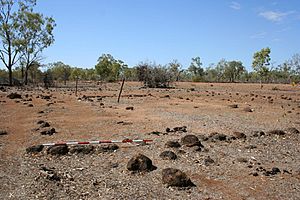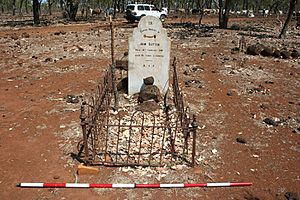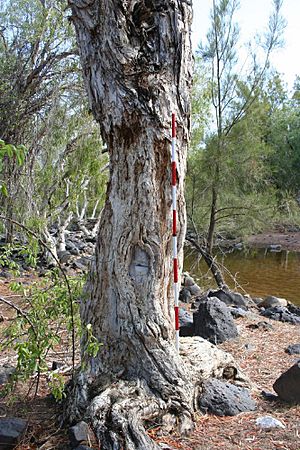Quartz Hill Coach Change Station facts for kids
Quick facts for kids Quartz Hill Coach Change Station |
|
|---|---|

Remains of the Quartz Hill Coach Change Station
|
|
| Location | Mount Surprise, Shire of Etheridge, Queensland, Australia |
| Design period | 1870s - 1890s (late 19th century) |
| Built | 1888 - 1908 |
| Official name: Quartz Hill Coach Change Station Site and Cemetery | |
| Type | state heritage (archaeological) |
| Designated | 4 July 2006 |
| Reference no. | 602232 |
| Significant period | 1888-1908 (historical) |
| Significant components | burial site, blazed tree/dig tree/marker tree, dump - bottle, grave surrounds/railings, dump - rubbish, cemetery, headstone, hotel / inn, cairn, track |
| Lua error in Module:Location_map at line 420: attempt to index field 'wikibase' (a nil value). | |
The Quartz Hill Coach Change Station Site and Cemetery is a special historical place near Mount Surprise, Queensland, Australia. It was once a busy stop for horse-drawn coaches carrying people and mail across North Queensland. Built between 1888 and 1908, it played a key role in connecting remote areas during the gold rush era. Today, it's a heritage-listed site, meaning it's protected because of its importance to history.
Contents
What Was a Coach Change Station?
Imagine traveling long distances before cars or trains! People used horse-drawn coaches. These coaches needed to stop regularly to change tired horses for fresh ones. A "coach change station" was like a pit stop for these coaches. Here, horses were fed and watered, and passengers could rest and eat. These stations were usually built near water sources, about 20 to 30 kilometers (12 to 18 miles) apart.
Why Was Quartz Hill Important?
The Quartz Hill Coach Change Station became important because of two big things happening in North Queensland:
- Pastoralism: This was the growth of large cattle and sheep farms.
- Mining: People discovered lots of gold, tin, and copper in the area.
These activities meant more people and goods needed to move around. So, in 1888, Quartz Hill became an overnight stop on a major coach route. This route connected the east coast (places like Herberton and Almaden) to the goldfields of Georgetown and beyond, all the way to Normanton on the Gulf of Carpentaria.
The Famous Cobb & Co. Coaches
The company that ran many of these coaches was called Cobb and Co. They were very famous for their coach services. In the late 1880s, Cobb & Co. extended their routes to cover the long distance between Georgetown and Herberton. This was a rough track, about 160 miles (257 km) long! Quartz Hill was a vital stop on this new route.
Life at the Station
A postal office opened at Quartz Hill in December 1888. The first person to run it was Mrs. Hutson. Her husband, Alfred Hutson, also got a license to run a hotel there in 1889. This meant travelers could get a meal and a place to sleep.
People like Arthur C. Bicknell, who traveled through in the 1890s, described Quartz Hill as having a "fairly good hut" run by an English couple. The station was a busy place where coaches met and exchanged mail.
The End of an Era
By the early 1900s, new ways of transportation started to appear. Railways were being built, making coach travel less necessary. For example, a railway line reached Mount Surprise in 1908. This meant people could travel by train instead of coach for parts of the journey.
Cobb & Co. sold their coach route in 1907. The Quartz Hill Hotel's license was no longer listed by 1909, and the postal office closed in July 1908. The coach change station had served its purpose, and its time had passed.
What Can You See Today?
The Quartz Hill Coach Change Station site is on the western bank of Elizabeth Creek. It's mostly open land with some trees near the creek. Even though the buildings are gone, you can still see interesting remains:
- The Cemetery: There are four graves here. The most famous is that of John Dutton, who was the postal office keeper in 1905. His grave has a marble headstone and an old cast-iron fence around it.
- Hotel Foundations: You can see the rectangular stone outlines of what was likely the hotel building. It was about 5 meters (16 feet) wide and 13 meters (42 feet) long.
- Bottle Dump: Near the creek, there's a large area where old green beer bottles and other rubbish were thrown. This shows where the hotel's waste ended up.
- Old Coach Road: You can still see parts of the original coach road that led to the creek crossing.
- Blazed Tree: A special tree, called a "blazed" tree, stands near the creek crossing. It has marks cut into its trunk, likely to guide travelers or mark the path.
These remains help us understand what life was like at a coach change station and how people traveled in the past.
Why is it a Heritage Site?
The Quartz Hill Coach Change Station Site and Cemetery was added to the Queensland Heritage Register on July 4, 2006. This means it's recognized as an important part of Queensland's history.
- Shows History: It helps us understand how North Queensland grew, especially with mining and farming. It shows how transport routes were created to support these industries.
- Teaches Us: The remains of the station, like the foundations, bottle dump, and cemetery, can teach us about how these stations were built and how people lived and worked there in the late 1800s and early 1900s. It's a great example of a type of place that no longer exists because of modern technology.




